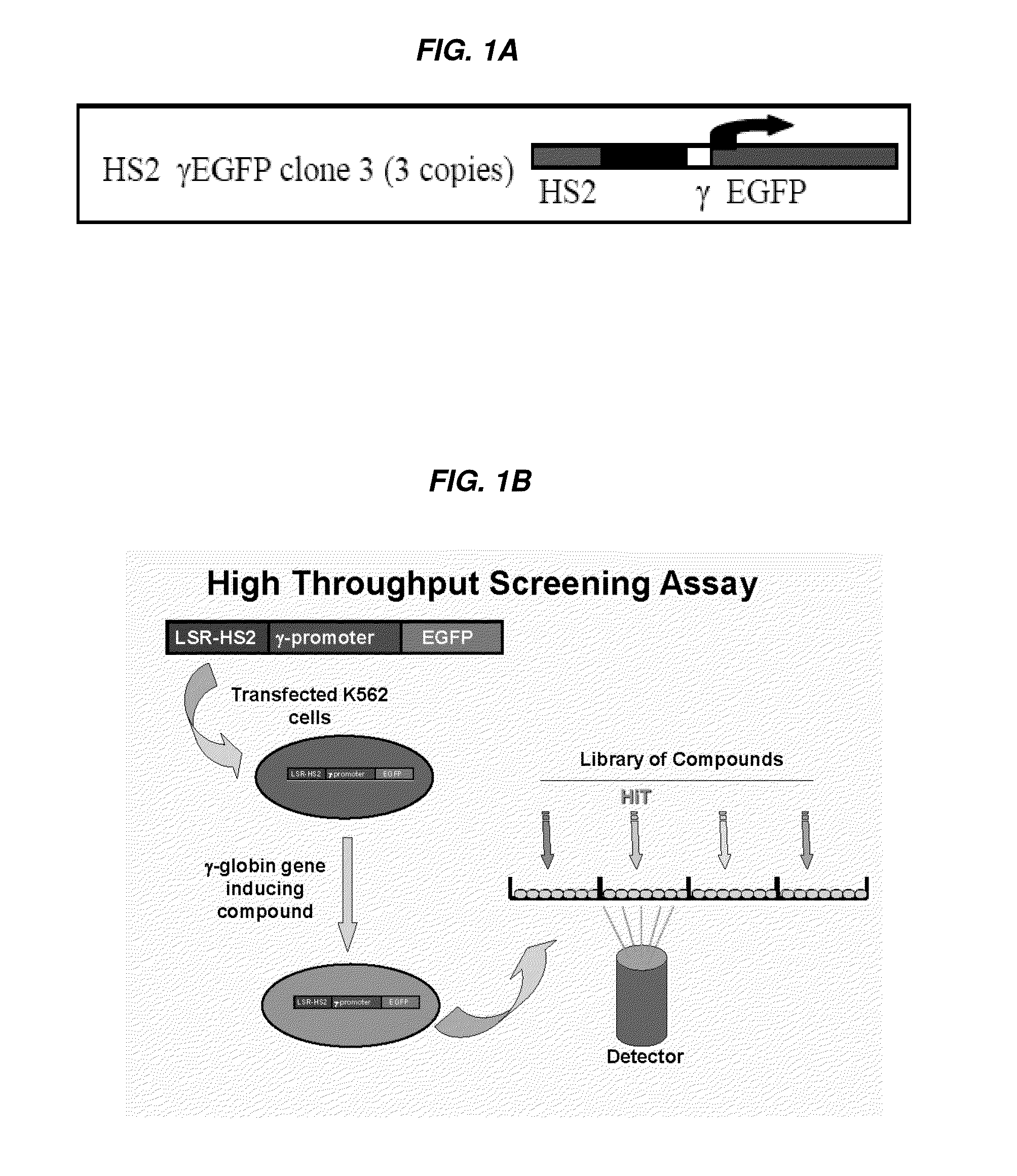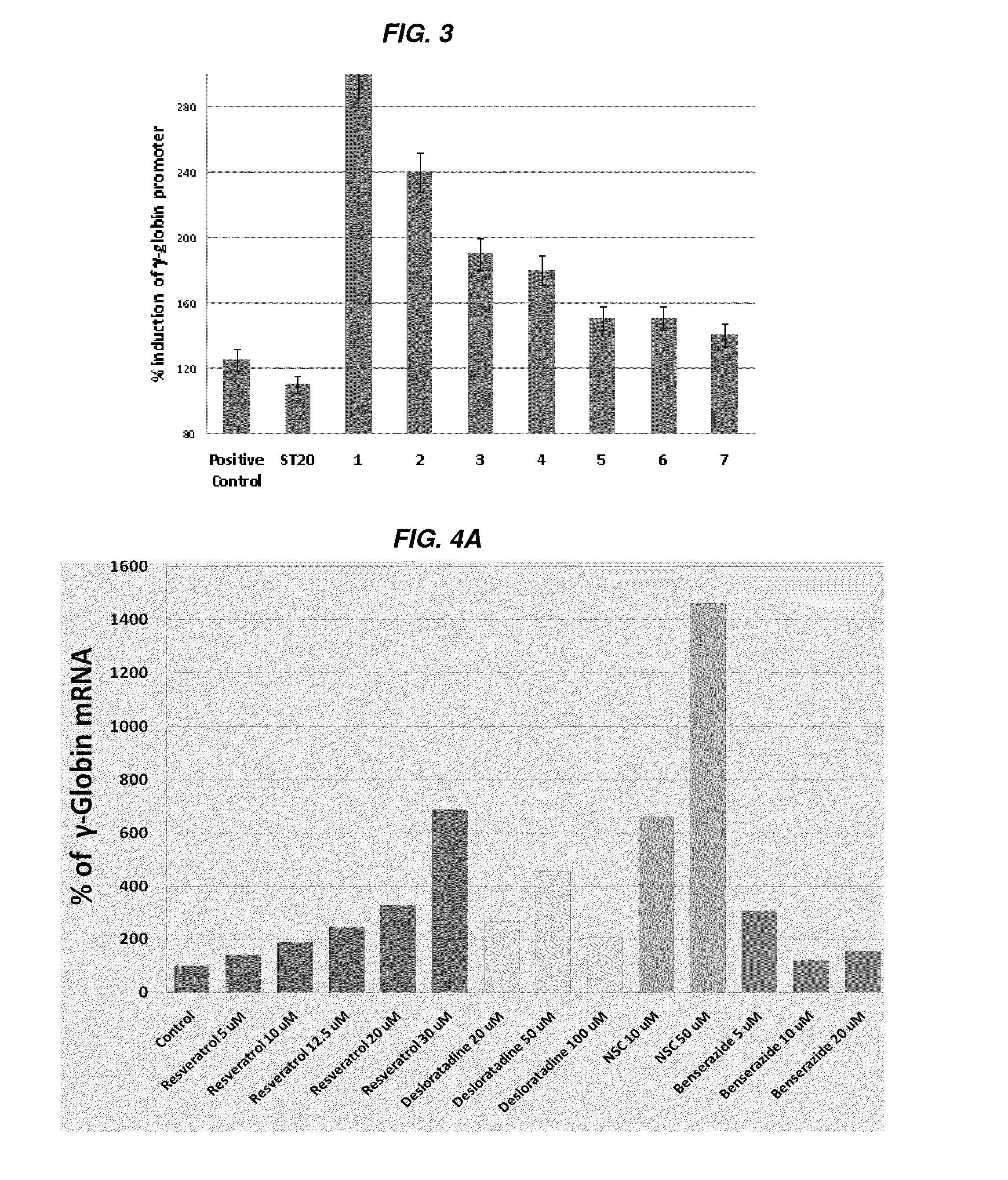Inducers of hematopoiesis and fetal globin production for treatment of cytopenias and hemoglobin disorders
a technology of hematopoiesis and fetal globin, which is applied in the direction of drug compositions, biocides, extracellular fluid disorders, etc., can solve the problems of hbf levels not being achieved in sufficient high degree to completely ameliorate all complications, and affecting the survival rate of patients. , to achieve the effect of stimulating the proliferation of hemoglobin producing cells and preventing blood disorders
- Summary
- Abstract
- Description
- Claims
- Application Information
AI Technical Summary
Benefits of technology
Problems solved by technology
Method used
Image
Examples
example 1
[0331]A human cell-based assay which was previously used in low throughput assays, utilizing a 1.4-kilobase (kb) KpnI-BglII fragment of the HS2 of the locus control region (LCR) linked to the γ-globin gene promoter and the enhanced green fluorescent protein (EGFP) reporter gene, was adapted for high throughput screening and employed as the primary screen (FIG. 1A). Cytotoxic activity was assayed in a simultaneous counter screen. A number of hits were identified as being more potent than positive controls (such as butyrate). Several hits were immediately eliminated from further development as potential hemoglobinopathy therapeutics because of cytotoxicity (e.g., Idarubicin) or undesirable off-target effects, but nonetheless validated the HTS itself and were validated in secondary confirmatory assays as highly-potent HbF-inducers.
[0332]The HTS assay identified eight FDA-approved drugs as potent inducers of γ-globin gene expression, with activity at 1-2 logs lower concentrations (1000-...
example 2
[0346]Chronically catheterized baboons were phlebotomized daily to create chronic anemia with total hemoglobin levels (Hb) between 7.0 to 7.5 g / dl which simulates the expanded erythropoiesis and anemia in sickle cell disease and beta thalassemia. Blood counts were drawn and total Hb (hemoglobin) and reticulocytes were analyzed on a hemavet analyzer. Fetal globin mRNA was analyzed by RT-PCR and proportions for f-cells were analyzed by flow cytometry. In one baboon, MS-275 (3 mg / m2), ST20 (positive control) were each administered for 2 weeks with a washout period between each test agent. Desloratidine (0.6 mg / kg) was administered for 4 days following a washout period. Blood counts were obtained at least 3 days / week. Hemoglobin levels were compared after 4 days of Desloratidine (0.6 mg / kg) treatment and after 4 days and 2 weeks of treatment with the positive control ST20 (sodium 2,2 dimethylbutyrate), MS-275 was given twice per week, and Desloratidine and ST20 were given daily (FIGS. 1...
example 3
Inducers of Fetal Globin and Hematopoiesis
[0347]Example of Increased Red Blood Cell Production Induced by Benserazide in an Anemic Nonhuman Primate Undergoing Daily Blood Withdrawal.
[0348]A third non-human primate experiment demonstrated that Benserazide increases hemoglobin levels and hematocrit % in blood in vivo. Baboon 1509 (weight 10.9 kg) was phlebotomized to induce anemia and marrow expansion, similar to the hemoglobin disorders. After phlebotomizing from hemoglobin level of 14.3 to 6.8 and then to a stable level with a phlebotomy volume of 37 mls of whole blood withdrawn daily, the hemoglobin level measured was to be at 7.6 g / dl and the hematocrit was 25.6%. After administration of Benserazide at 1 mg / kg and then 2 mg / kg, the hemoglobin level increased to 8.9 g / dl and the hematocrit increased to 28% by 2 weeks after administration and despite the continuing blood withdrawal daily. This result strongly demonstrated that Benserazide (at doses of at least 1 mg / kg and 2 mg·kg) s...
PUM
| Property | Measurement | Unit |
|---|---|---|
| diameter | aaaaa | aaaaa |
| time | aaaaa | aaaaa |
| time | aaaaa | aaaaa |
Abstract
Description
Claims
Application Information
 Login to View More
Login to View More - R&D
- Intellectual Property
- Life Sciences
- Materials
- Tech Scout
- Unparalleled Data Quality
- Higher Quality Content
- 60% Fewer Hallucinations
Browse by: Latest US Patents, China's latest patents, Technical Efficacy Thesaurus, Application Domain, Technology Topic, Popular Technical Reports.
© 2025 PatSnap. All rights reserved.Legal|Privacy policy|Modern Slavery Act Transparency Statement|Sitemap|About US| Contact US: help@patsnap.com



